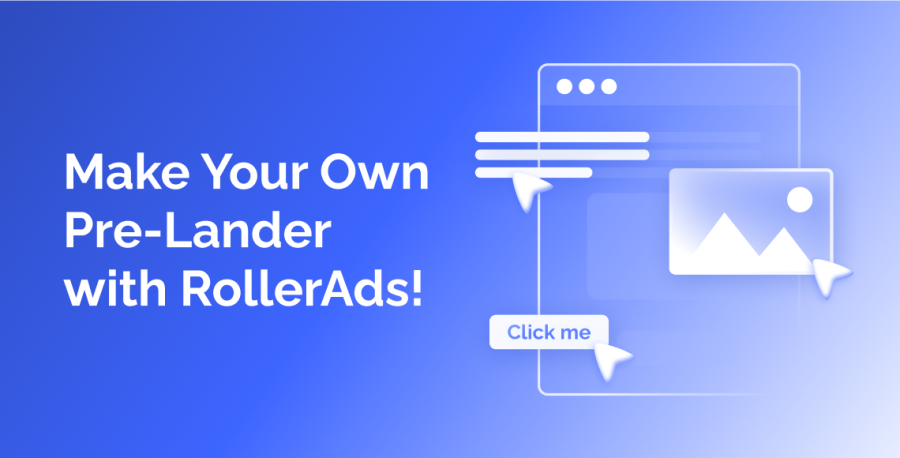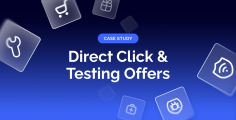We’ve already covered the definition of pre-landers, as well as frequently asked questions about them. Now is the time to explain how to make a pre-lander of your own, step by step.
This is the final article dedicated to pre-landers. Here, we’ll go from ideation to realization of your pre-landers. We’ll explain where to find ideas, why and how to park a domain, what tools you need, how to set up analytics, and some other nuances. Ready to make a pre-lander?
Pre-Lander 101
Pre-lander is a preliminary page, appearing before the landing page. It follows an ad creative: specifically, the user is to click on an ad (or, in case of pop ads, trigger it) for the pre-lander to appear.
Pre-landers are not obligatory, unlike landing pages, but they can be handy to have. Formally speaking, landing pages are handed over by the product owners and affiliates cannot make any adjustments to them. Since the affiliates control only pre-landers, we’ll talk about them exclusively, even when referring to them as “landing pages” or “landers”.
They are ideal for complex funnels or when you just want more credibility. Specifically, you can use them to:
- Warm up traffic and generate interest in a product.
- Convey more info and add social proof.
- Overcome sales objections and increase conversions.
- Filter out untargeted traffic to improve KPIs.
- Present different offers to diverse user groups.
- Facilitate ad campaign moderation by meeting quality standards, e.g., turn auto-downloaders into traditional software.
Nonetheless, keep in mind that pre-landers are an extra step, which is to be justified. A poorly designed or out-of-place pre-lander will raise suspicions and ultimately scare the user away. To make pre-landers relevant and integral, you need to know the purpose of adding them.
Taking a Pre-Lander
Having made up your mind about the purpose, you need to decide how much effort you’re ready to invest into building a pre-lander. It ranges from doing everything manually for a perfect match with the rest of the funnel elements to simple copy-pasting.
Stealing pre-landers is not only unethical but economically unfeasible. See, by copying the landers of the others, you get second-hand ads, which have already been run for some time. The users tend to get accustomed and ad blind.
That’s why we suggest building your own pre-landers when needed.
Pre-Made Pre-Landers
Depending on the affiliate network and advertiser, you might get access to a set of pre-landers. Make sure to read the terms and conditions of the offer carefully.
Besides not making a pre-lander at all, this is the path of least resistance. You get a readily available item for your needs, but so do the other affiliates, promoting the same offer. Don’t expect mind-blowing results when using the already available materials.
Spying
If you’re fine with following the traces of the others, then identify the competitors’ ads first, using Google Ads Transparency Center. This will help initially to find out how the competitors perform and what converts best for them.
Tools like Anstrex are paid alternatives with more insights and wider ad coverage, which goes beyond pop ads, a typical pick for pre-landers. For more tools for making creatives, refer to our dedicated article.
The next step is to either extract a lander or use it as a source of inspiration for making your own. Let’s start with the former.
Extracting a Pre-Lander
You need a special tool to extract a pre-lander, like TurboLander or PureLander. The former is a no-code landing page builder tailored for top affiliate marketers, aiming to boost affiliate income through its features:
- Copy and tweak: Allows users to copy and modify landing pages quickly, saving time and resources.
- Effortless import: Offers a universal page importer to import existing landing pages via URL and publish with one click.
- Fast deployment: Give users an ability to go live in less than 60 seconds without requiring extra hosting or coding skills (much like our case study about Auto-generated creatives).
- TurboLander Pro: Offers advanced features including unlimited pages and traffic, hosting, import options, custom domains, tracking integration, analytics insights, and a no-code page editor.
Store Your Pre-Landers
In case TurboLander hosting services don’t cater to your needs, you can also store your pre-landers elsewhere, using dedicated solutions for virtual private servers (VPS), e.g., Digital Ocean or Google Cloud.
Affiliate networks can provide their domains to host your pre-landers for free. If that’s not the case, or you prefer some specific domain or other servers, make sure to find a domain registrar and register your domain there. Here’s how it works:
- Choose a domain name: Select a catchy and relevant domain name for your website. Ensure it aligns with your business name and brand.
- Select a domain registrar: Select a reputable domain registrar to register your domain name. Consider factors like cost, privacy protections, and additional services offered.
- Purchase and register your domain name: Once you’ve selected a registrar, purchase your domain name for a nominal fee, typically around $10 to $15 per year. Pay attention to registration duration and consider auto-renewal options.
- Familiarize yourself with the domain name contract: Understand the terms of the domain name contract to avoid surprises regarding your rights and obligations.
- Don’t lose the domain name: Ensure timely renewal of your domain name to maintain ownership and prevent it from being scooped up by others.
Even if you don’t have a specific design right away, it’s a good idea to park a potential domain anyway. Nice-sounding domains are hard to come by, and they might be long gone by the time you finish making a pre-lander.
By this time, you have a borrowed pre-lander. You need to input its URL into the campaign settings.
Register on RollerAds to try out your new pre-landers and watch your campaign performance soar with the help of our features, like flexible targeting settings, traffic estimator, traffic presets etc.
But what if you want to add an extra touch to the pre-landers borrowed? Or what if you want to design it from scratch?
Make Pre-Landers
A good pre-lander takes time and effort, but it’s worth the shot. It looks integral to your funnel and boosts your credibility. Besides, it will be unique, meaning the users are more likely to perceive it better.
Free Stocks to Power Up Creativity
If you haven’t borrowed a pre-lander using a spy tool or an advertiser hasn’t provided you with one, then you need to find free stock images to get materials for your pre-landers. Check out web stocks, like Vecteezy, Unsplash, and Freepik.
Don’t forget about the available templates, integrated into landing page builders. Using WordPress, Wix, or Canva simplifies landing page creation.
Building a Pre-Lander
The tools for making pre-landers are numerous. TurboLander, PureLander, Wix — they all get the job done. It doesn’t matter which tool you’re using, but you should focus on specific key points related to design:
- Avoid copying existing pages; instead, consider customization or creating from scratch.
- Utilize ready-made templates for simplicity and cost-effectiveness.
- Ensure authenticity, relevance, and quality of content, visuals, and design.
- Incorporate before-and-after visuals, testimonials, and dynamic elements.
- Use intriguing headlines, natural product links, and authentic reviews for credibility.
It’s a great idea to tell a story during the user’s journey. It boils down to 5 key elements.
- Hero: this is your audience, and you’re to provide here a relatable story.
- Problem: some issue that the hero is to solve, e.g., depression.
- Guide: that’s an assistant who will help the hero along the way, e.g., a medical website.
- Remedy: that’s the magic problem solver, e.g., unique nutra pills.
- Reflections: it’s time to reflect on the results your hero has achieved by following the guide’s advice and using the remedy — an ideal spot for before and after comparison.
By skipping a single stage, you’re depriving the users of a chance to relate to you and your product. Make sure all 5 elements are present in your funnel, they don’t have to be stuffed into just a pre-lander.
If you’re working with exotic GEOs, you need a translator to localize your content. This can also be done via AI tools. Make sure to learn the local specifics using the Country Comparison Tool.
How to Analyze Landing Pages
Data analysis helps to make better decisions. It’s not limited to a large scale of campaigns; you can also analyze landers. Landing page analysis is an ongoing process to evaluate primary and secondary performance indicators along with visitor behavior on landing pages.
Primary indicators. These are fundamental metrics directly related to the core objectives of your landing pages, such as driving conversions and measuring overall performance.
- Traffic: Total views of the landing page.
- Visitors: Unique individuals who viewed the landing page.
- Conversions: Instances of desired actions (e.g., form fills).
- Conversion rate: Percentage of visitors who completed the desired action.
- Page load speed: Impact on user experience and conversions.
Secondary indicators. These metrics provide additional context and insights into the performance of your landing pages, often focusing on specific segments or aspects of visitor behavior.
- Device-level performance: Optimization for desktop, tablet, and mobile.
- Country-level performance: Insights on regional performance for targeting.
- Browser and OS-level performance: Understanding user preferences for browser compatibility.
User behavior analysis. It delves deeper into how visitors interact with your landing pages and the elements that influence their actions. Consider visualizing the following elements.
- Heatmaps: Visualize user engagement and interaction.
- Scroll depth: Determine the optimal length of landing pages.
Use a 3rd-party tracker, like Binom, to access most of the data. Tools like Hotjar can be used to create heatmaps. As for scroll depth, Google Analytics should be enough.
A/B Testing
A/B testing is crucial when building pre-landers because it allows you to experiment with different elements such as design, content, and visuals to determine what resonates best with your audience.
When designing a pre-lander, there are several elements you can experiment with through A/B testing to optimize its performance and increase conversion rates. Here are some key aspects you can consider testing:
- Headline: The headline is often the first thing visitors see, so testing different headline variations can significantly impact engagement. Experiment with different wording, lengths, and formats to see which resonates best with your target audience.
- Call-to-Action (CTA) button: Test variations in CTA button text, color, size, and placement. Sometimes even small changes in the CTA button can lead to significant improvements in conversion rates.
- Images and graphics: Test different images or graphics to see which ones capture visitors’ attention and encourage them to take action. This could include product images, lifestyle images, or graphics that emphasize key benefits.
- Copy: Experiment with different copywriting approaches, tones, and messaging styles to see which resonates best with your audience. This includes not only the main body copy but also subheadings, bullet points, and testimonials.
- Social proof: Incorporate social proof elements such as customer testimonials, reviews, case studies, or trust badges, and test their placement and prominence on the pre-lander.
- Form fields (if applicable): If your pre-lander includes a form for capturing leads or information, test different form field layouts, lengths, and required fields to minimize friction and maximize conversions.
- Layout and design: Test different layouts, color schemes, fonts, and overall design elements to create a visually appealing and easy-to-navigate pre-lander that encourages engagement.
- Video content: If applicable, experiment with including video content on your pre-lander. Test different video lengths, content types, and placements to see how they impact engagement and conversion rates.
- Offer presentation: Test variations in how you present your offer or product benefits. This could include highlighting different features, emphasizing discounts or promotions, or framing the offer in a way that addresses specific pain points or desires of your target audience.
- Mobile responsiveness: Ensure your pre-lander is optimized for mobile devices, and test different mobile layouts and designs to ensure a seamless user experience across all devices.
Remember to test one element at a time to accurately measure the impact of each change, and be sure to collect sufficient data before drawing conclusions. A/B testing is an iterative process, so continue to refine and optimize your pre-lander based on the insights you gather from your tests.
Don’t know how many tests you should run? Here is a statistical significance calculator, i.e., when the changes in lead behavior can no longer be caused by a coincidence or chance.
Conclusion
Building pre-landers involves a systematic approach, from ideation to realization. Pre-landers serve as crucial intermediaries between ads and landing pages, offering opportunities to warm up traffic, convey more information, overcome objections, and present diverse offers.
Whether creating pre-landers manually or using tools, authenticity and relevance are key. Integration of analytics ensures effective tracking, while A/B testing enables refinement for optimal performance. By understanding the purpose and employing best practices, affiliates can harness the power of pre-landers to enhance the success of their marketing campaigns.





